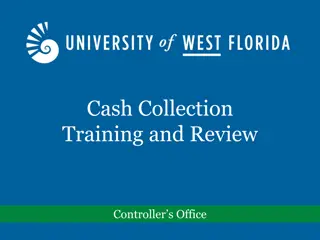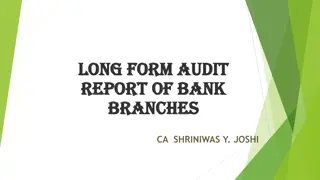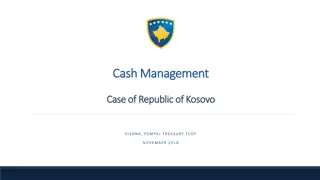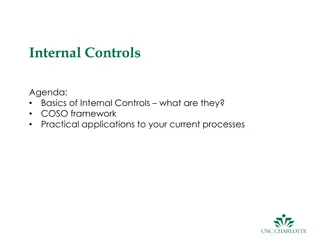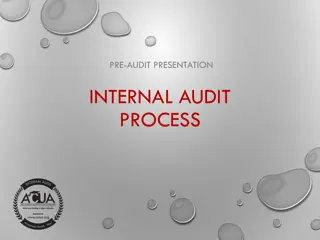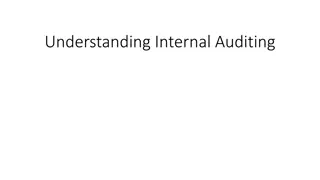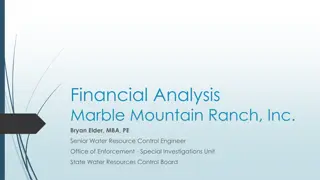Principles of Internal Control in Cash Management
Learn about the principles of internal control in cash management, including procedures to reduce risk, segregation of duties, establishment of responsibility, and documentation procedures. Internal control aims to safeguard assets, enhance accuracy in accounting records, and prevent errors and irregularities in the accounting process.
Download Presentation

Please find below an Image/Link to download the presentation.
The content on the website is provided AS IS for your information and personal use only. It may not be sold, licensed, or shared on other websites without obtaining consent from the author.If you encounter any issues during the download, it is possible that the publisher has removed the file from their server.
You are allowed to download the files provided on this website for personal or commercial use, subject to the condition that they are used lawfully. All files are the property of their respective owners.
The content on the website is provided AS IS for your information and personal use only. It may not be sold, licensed, or shared on other websites without obtaining consent from the author.
E N D
Presentation Transcript
Cash Management Larry Brownfield, CPO, OHE KOA, Inc. Possible IACET CEU s:
COURSE OBJECTIVES 1. Identify procedures to help reduce your risk related to cash management. 2. Describe why separation of duties is important with cash management.
IDENTIFYTHE PRINCIPLESOF INTERNAL CONTROL Internal control consists of all of the related methods and measures adopted within a campground to: Safeguard assets from employee theft, robbery, and unauthorized use Enhance the accuracy and reliability of its accounting records by reducing the risk of errors (unintentional mistakes) and irregularities (intentional mistakes and misrepresentations) in the accounting process.
IDENTIFYTHE PRINCIPLESOF INTERNAL CONTROL 1. Establishment of Responsibility: An essential characteristic of internal control is the assignment of responsibility to specific individuals. Control is most effective when only one person is responsible for a given task. Establishing responsibility includes the authorization and approval of transactions.
IDENTIFYTHE PRINCIPLESOF INTERNAL CONTROL 2. Segregation of Duties: Segregation of duties is indispensable in a system of internal control. The rationale for segregation of duties is that the work of one employee should, without a duplication of effort, provide a reliable basis for evaluating the work of another employee.
IDENTIFYTHE PRINCIPLESOF INTERNAL CONTROL Segregation of Duties: There are two common applications of this principle: The responsibility for related activities should be assigned to different individuals. The responsibility for record keeping for an asset should be separate from the physical custody of an asset. See handout: Related Activities
IDENTIFYTHE PRINCIPLESOF INTERNAL CONTROL 3. Documentation Procedures: Documents provide evidence that transactions and events have occurred. Documents should be pre-numbered and all documents should be accounted for. Source documents for accounting entries should be promptly forwarded to the accounting department to help ensure timely recording of the transaction and event.
IDENTIFYTHE PRINCIPLESOF INTERNAL CONTROL 4. Physical, Mechanical, and Electronic Controls: Physical controls relate primarily to the safeguarding of assets. Mechanical and electronic controls safeguard assets and enhance the accuracy and reliability of the accounting records. Use of physical, mechanical, and electronic controls is essential. Examples of these controls include: Safes, vaults, and safety deposit boxes for cash and campground papers. Locked storage cabinets for inventory and records. Computer facilities with pass key access or fingerprint or eyeball scans. Alarms to prevent break-ins. Video monitoring deter theft. Time clocks for recording time worked.
IDENTIFYTHE PRINCIPLESOF INTERNAL CONTROL 5. Independent Internal Verification: Independent internal verification involves the review, comparison, and reconciliation of data prepared by employees. Verification should be made periodically or on a surprise basis. Verification should be done by an employee independent of the personnel responsible for the information. Discrepancies and exceptions should be reported to a management level that can take appropriate corrective action.
IDENTIFYTHE PRINCIPLESOF INTERNAL CONTROL 5. Independent Internal Verification: Independent internal verification involves the review, comparison, and reconciliation of data prepared by employees. In large campgrounds, independent internal verification is often assigned to internal auditors. Internal auditors are employees of the company who evaluate on a continuous basis the effectiveness of the company s system of internal control. They periodically review the activities of departments and individuals to determine whether prescribed internal controls are being followed.
IDENTIFYTHE PRINCIPLESOF INTERNAL CONTROL 6. Other Controls Bonding of employees who handle cash. Rotating employees' duties and requiring employees to take vacations.
LIMITATIONSOF INTERNAL CONTROL Internal control is designed to provide reasonable assurance that assets are properly safeguarded and that the accounting records are reliable. The human element is important in internal control. The size of the campground may impose limitations on internal control. In a small campground, for example, it may be difficult to apply the principles of segregation of duties and independent internal verification.
APPLICATIONSOF INTERNAL CONTROLTO CASH RECEIPTS Establishment of responsibility - Only designated personnel are authorized to handle cash receipts. Segregation of duties - Different individuals receive cash, record cash receipts, and hold the cash. Documentation procedures - Use remittance advice (mail receipts), cash register tapes, and deposit slips. Physical, mechanical, and electronic controls - Store cash in safes and bank vaults; limit access to storage areas; use cash registers. Independent internal verification - Supervisors count cash receipts daily; treasurer compares total receipts to bank deposits daily. Other controls - Bond personnel who handle cash; require vacations; deposit all cash in bank daily.
APPLICATIONSOF INTERNAL CONTROLTO CASH DISBURSEMENTS Cash is disbursed to pay expenses and liabilities or to purchase assets. NOT BEST PRACTICE! Establishment of responsibility - Only designated personnel (treasurer) are authorized to sign checks. Segregation of duties - Different individuals approve and make payments; check signers do not record disbursements. Documentation procedures - Use pre-numbered checks and account for them in sequence; each check must have approved invoice.
APPLICATIONSOF INTERNAL CONTROLTO CASH DISBURSEMENTS Cash is disbursed to pay expenses and liabilities or to purchase assets. NOT BEST PRACTICE! Physical, mechanical, and electronic controls - Store blank checks in safes with limited access; print check amounts by machine with indelible ink. Independent internal verification - Compare checks to invoices; reconcile bank statement monthly. Other controls - Stamp invoices PAID.
APPLICATIONSOF INTERNAL CONTROLTO CASH DISBURSEMENTS Cash is disbursed to pay expenses and liabilities or to purchase assets. NOT BEST PRACTICE! Petty Cash Fund - A cash fund used to pay relatively small amounts. BEST PRACTICE! Use of a Bank Contributes significantly to good internal control over cash. See Handout for suggested procedure
REVIEW PRINCIPLESOF INTERNAL CONTROL Internal Controls Hire with trustworthiness as a criteria Fiscal responsibilities in position descriptions Duties divided no start to finish handling Procedures and forms to support controls
REVIEW PRINCIPLESOF INTERNAL CONTROL Internal Controls Reduce cash transactions Cash sales only at cash registers Spot checks throughout cash handling processes Avoid use of petty cash, use company purchase cards Situational awareness
REVIEW PRINCIPLESOF INTERNAL CONTROL Separation of Duties No one person handles a transaction from start to finish Used for cash handling, payroll, timekeeping Options include outsourcing; controls created in accounting software
WHATABOUT CREDIT CARDS? PCI compliance (payment card industry compliance) Payment card industry (PCI) compliance is adherence to a set of specific security standards that were developed to protect card information during and after a financial transaction. PCI compliance is required by all card brands.
WHATABOUT CREDIT CARDS? PCI compliance (payment card industry compliance) 1. Build and maintain a secure network Install and maintain a firewall configuration to protect cardholder data. Not use vendor-supplied defaults for system passwords and other security parameters.
WHATABOUT CREDIT CARDS? PCI compliance (payment card industry compliance) 2. Protect cardholder data Protect stored cardholder data. Encrypt transmission of cardholder data across open, public networks.
WHATABOUT CREDIT CARDS? PCI compliance (payment card industry compliance) 3. Maintain a vulnerability management program Use and regularly update anti-virus software. Develop and maintain secure systems and applications.
WHATABOUT CREDIT CARDS? PCI compliance (payment card industry compliance) 4. Implement strong access control measures Restrict access to cardholder data by business need-to-know. Assign a unique ID to each person with computer access. Restrict physical access to cardholder data.
WHATABOUT CREDIT CARDS? PCI compliance (payment card industry compliance) 5. Regularly monitor and test networks Track and monitor all access to network resources and cardholder data. Regularly test security systems and processes.
WHATABOUT CREDIT CARDS? PCI compliance (payment card industry compliance) 6. Maintain an information security policy Maintain a policy that addresses information security C.F. PCI FAQs (Handout)
COURSE OBJECTIVE REVIEW 1. Identify procedures to help reduce your risk related to cash management. 2. Describe why separation of duties is important with cash management.














